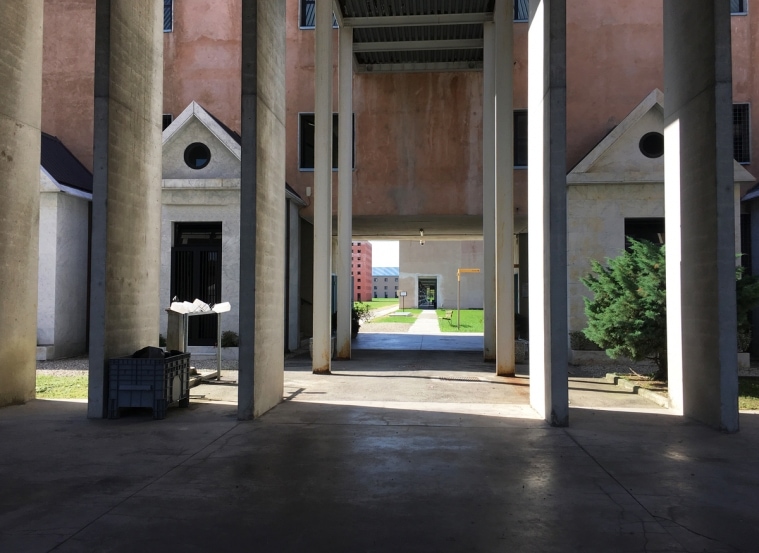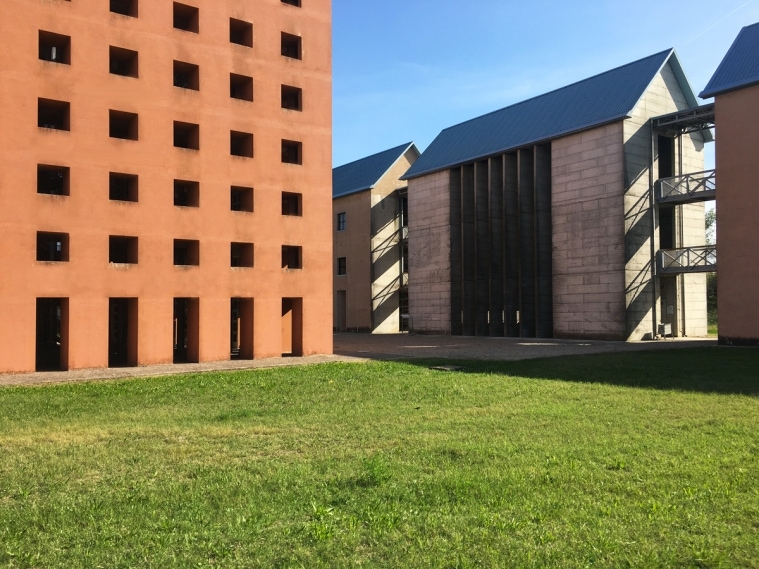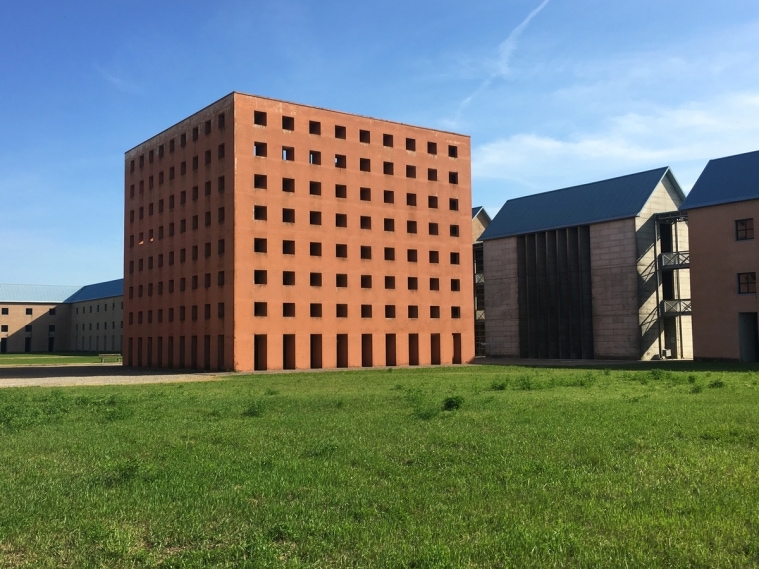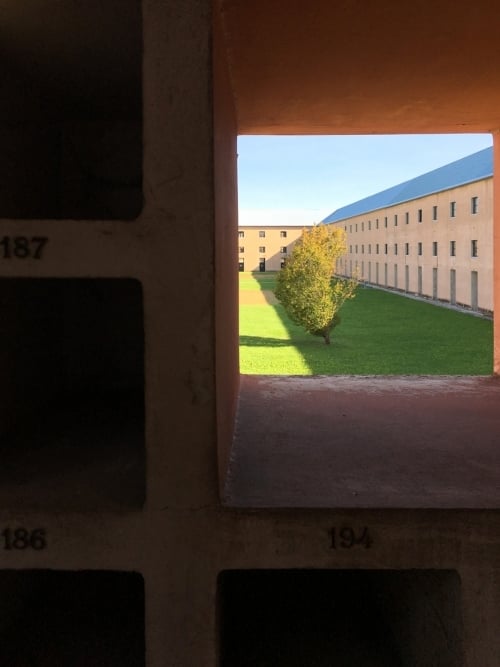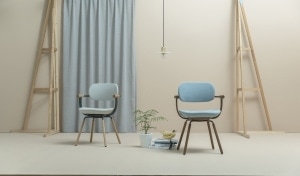An architect who happens to be a poet
Ada Louise Huxtable, architectural critic and Pritzker juror
When I was a little, child I used to play with geometric wooden toys. Squares, triangles, circles. I loved them. I especially loved the way they fix through their corresponding carved shapes in my wood table. I grew up and my fantasy as well; I started to use them to build single structures and then entire scenarios: Just a few shapes and endless possibilities to play.
I am still fascinated by those toys, whose roots belong to an unspecified past and the childhood of billions of children in history. In spite of everything, they remain the basis of almost all contemporary educational methods: by understanding simple geometric shapes the child comes to master volumes and compositions of space. A seemingly simple operation that allowed us all to manipulate an imaginary reality to our will.
Contents
Aldo Rossi (1931-1997)
Aldo Rossi is an Italian architect who managed to manipulate our reality and to solve the problem of inhabiting the world. He highlighted his unique approach through a personal and unmistakable language in Architecture, which was characterized by very few repeated elements. His crystalline and provocative simplicity has often been misunderstood as mere schematism. Nothing’s more wrong. Rossi has designed a synthesis of his “urban utopia” conceiving it as a composition of simple juxtaposed element which are stored in our collective memory, the so-called archetypes.
Archetypes
Rossi was obsessed with the idea of giving sense to the architect's effort as well as with the social importance of designing spaces.
In his constant research, Rossi created a language which ideally sums up all the architectural styles over the centuries, identifying them in a series of elementary geometric shapes, the fil-rouge of his poetry. In this way, he built a meeting point between past and present, between tradition and modernity.
The architecture returns to the primal forms to revoke its prime intent.
Far from the pure functionalism and against the formal stereotypes that he traced out in the International Style, he led a new vision that would orient and guide the good architectural practice.
He wrote the “Architecture of the City” (1966), one of the most influential books ever written by an architect. In this book, he proposes an objective re-foundation of the discipline which couldn’t still be self-referential anymore. It had to return within its historical coordinates and to its main social function: the conception of the city.
Last but not least, Aldo Rossi was also passionate about theatre and cinematography. His works are far from just being a styling exercise. Every single project brings instead a heavy drama inside: the elements are not just “represented”, they are “acting”. The space becomes a stage. And the architectures constantly dialogue between them just as much with the inhabitants and time.
Thanks to his uniqueness, he became the first Italian architect to win the Pritzker Prize (1990).
San Cataldo Cemetery by Aldo Rossi (1971)
This project, designed with Gianni Braghieri, is considered a masterpiece. The drawings are exhibited in MoMA, New York, and tourists came from all over the world to visit this Post-Modern monument, which summarizes the complexity of the architect’s poetical and theoretical approach.
1971 - The Municipal Administration of Modena (Italy), announces a national call for ideas to expand the ancient cemetery Cesare Costa (1858-1876). The competition particularly focuses on the philosophical and religious contents, rather than architectural pioneering or futuristic technological aspects. The competition aims to conceive a real monumental symbol for Architecture and the local community.
As mentioned above, architecture represents an all-encompassing experience for Rossi, and every project is the outcome of a unique mix of personal researches and subjective experiences. The fundamental event which occurred before the design of the cemetery was a terrible automobile accident that happened on his way to Istanbul. The event caused him a long period of infirmity: during this time, due to the pain caused by his fractured bones, he found himself to identify death with the skeleton morphology, as he reports in his book “A Scientific Autobiography” (1981). This event also defined the end of his youth.
The city of dead
Aldo Rossi's cemetery is everything that we could least expect from a classic cemetery. The access is through a very long concrete porch.
Suddenly, from a distance, we can start to see something: a huge lawn, some sharped lines, an intense blue, and a large orange cube.
“Where am I?” The question arises.
While on the one hand, the “city of the living” is the theater where human activities take place, the cemetery is “the city of the dead” where everything is motionless.
The structure
As we enter, we are projected into a seemly never-ending perspective. Death is eternal. It seems to be in one of those metaphysical landscapes of Giorgio De Chirico, the Italian painter who used clear volumes, spatial illusions, shadow projections, and a tangible silence to create paralyzed scenarios. Aldo Rossi was deliberately inspired by his works, and he uses the same communication to conceive blocking-time- architectures.
The composition is based on a few recognizable elements: cubes, triangles, rectangles. They create a contrast with the ancient cemetery.
But the aim is not breaking with the past. Rossi builds an extension of the old one by duplicating the space, using the "past" as a canvas. The cemetery follows the dimensional aspects in every way: the Costa building measures 180x272 meters, while the new expansion is 180x280 meters. With this design gesture, the architect tries to "solve" an inconclusive symmetry, by reconnecting the new to the pre-existence of the old.
The fence
The fence is an architectural spatial archetype that represents the primordial concept of differentiation between interior and exterior as well as the first symbol used by man to differentiate sacred space from the rest.
Rossi and Braghieri do not treat it as a simple wall but they connote it as a volumetric element in which corpses rest inside. The entire fence is covered by a triangular section roof, an arc with an absence of resolution.
The choice is not dictated by a technical need but is justified by a clever attempt to harmonize the structure to the urban context of Modena, creating a structural continuity. After creating an ideal continuity with the cemetery, the architecture seeks a dialogue with the city in which it is hosted. Modena is characterized by the modular and rhythmic element of the arcades, all along the city center.
The cube
This is the center of the composition. The atmosphere is almost familiar. The cube represents a house but is a sinister house, the house of the deceased precisely. We face another primitive form and a second architectural archetype: the house of the dead, which is always represented by an abandoned house in architecture.
For such reason, the cube has no doors, no roof, and it is covered in holes: it is the ossuary of the cemetery. The holes are specularly connected inside with the niches that house the bones.
The object appears unfinished: a symbol of a life suddenly broken.
Johannes Itten, talking about composition, affirmed that the square is a symbol of materiality and it corresponds to the color red, which is the color of matter. In the cube, the vision of death is communicated with the struggle that the event brings with it, in contrast with the typical Catholic vision according to which the soul transfers to a better place.
From the cube begins the ideal ascent that Aldo Rossi had foreseen from the original project.
The central spine and the cone
The original project included two additional structures: a triangular section herringbone structure and a 25- meters-high cone with a circular section. The initial intent was designing that spiritual ascent to the divine dimension. In other words, the harmony of the composition had to be given by the co-presence of all the primary geometric shapes and their symbolical meaning. Square, triangle, circle.
What we can see now, is a minimal percentage of the project, which has remained unfinished.
In this metaphysical landscape, the tiny visitor is surrounded by gigantic forms that exalt the perception of reality precisely in its negation. It seems to be in a disturbing scenario that a child has built, but it's all real and formally calculated. A picturesque landscape in which we find ourselves lost, a place without time except for the natural flow of it (the shadows created by the cyclic movement of the sun, became a pictorial element that enriches the composition).
Time becomes objective, non-human, cyclical, and inexorable. The disturbing sensation is the unique contrast between the living visitor and the still life immersed in total deafening silence. The structures look at each other and communicate from every angle, but speak a language that we cannot hear, the language of death.
The result is all-encompassing: the visitor is struck by the strongest feeling a cemetery can give rise to, a palpable absence.
Info
| Name | Aldo Rossi San Cataldo Cemetery |
| Location | Modena, Italy |
| Entrance | Free |
| About Aldo Rossi | FondazioneAldoRossi www.fondazionealdorossi.org |

 English
English 日本語
日本語
